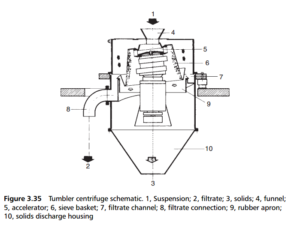0
-
An empty cart
You have no item in your shopping cart
envato-wordpress-toolkit domain was triggered too early. This is usually an indicator for some code in the plugin or theme running too early. Translations should be loaded at the init action or later. Please see Debugging in WordPress for more information. (This message was added in version 6.7.0.) in /var/www/wp-includes/functions.php on line 6121g5plus-darna domain was triggered too early. This is usually an indicator for some code in the plugin or theme running too early. Translations should be loaded at the init action or later. Please see Debugging in WordPress for more information. (This message was added in version 6.7.0.) in /var/www/wp-includes/functions.php on line 6121There are two main designs of moving bed centrifuge: those with a cone-shaped basket and those with a cylindrical basket. In the latter, solid movement needs mechanical assistance, but in the conical basket, the solids are potentially free to slide from the narrow end of the cone, which is where the feed zone is, to the wide end for solids discharge. The ability of the solids to slide in this fashion is dictated by the angle of repose of the solid particles, which varies from a quite high value when the solids are dry, to practically zero as a thin slurry. As the solids flow along the basket, the concentration of solids increases, and with it the repose angle. If this exceeds the angle of the cone, before the solids reach the end of the basket, then the solids will flow no further and will build up in the basket. If, on the other hand, this angle is not exceeded within the basket, then the solids will flow on to the edge of the basket and so out of it.
The dry angle of repose varies considerably among the range of solids that might be considered for separation in a conical basket centrifuge, and the manufacturer is thus faced either with having to make baskets with a different cone angle for each
solid to be processed, or to find a way of controlling the rate of movement across the screen surface. There are some applications for which the large annual capacities justify the provision of a single angle cone, but, more commonly, flow control mechanisms are installed, enabling the centrifuge to be used for a range of feed slurries.
Solid flow control may be necessary to speed up the flow, of solids which have become too dry to reach the end of the basket, or to slow the flow down, for those slurries that would otherwise wash off the basket before they were sufficiently dewatered. A simple means of removing solids held in a basket (simple, that is, in operational principle, though not necessarily in mechanical structure) is to use a screw conveyor – which cannot be in contact with the basket or screen wear will occur.
Like the scroll discharge version, the other solid flow control machines are intended for a screen that has too shallow an angle for the solids to discharge, and then provide different mechanisms for acceleration. One of these uses torsional vibration (an acceleration-deceleration motion imposed on the basic basket rotation), and the amount of vibration is adjusted to give the required solid flow rate. Another version is the tumbling centrifuge, shown in Figure 3.35. Here the basket is tilted at a slight angle to the vertical axis about which it is rotating. In this way, each vertical slice of the basket makes a different angle to the vertical as it rotates, and therefore the solids on that slice are successively accelerated and decelerated towards the end of the basket.

A different form of the conical basket centrifuge is found in the baffle-ring centrifuge. Here, the basket is divided into several frusta by a set of parallel rings protruding from the surface of the basket. This machine was developed for the dewatering
of plastic granules, which is promoted by the impact between aggregates of granules and the baffle rings. The granules pile up against each baffle and then tumble over it onto the next section of basket.